A ray of hope for breast cancer victims
October 30, 2002 | 12:00am
Several years ago, women with breast cancer had to undergo radical mastectomy: the complete removal of the breast, the surrounding lymph nodes, and some of the pectoral muscle underneath.
This usually leaves the patient in a state of depression — they feel they are no longer attractive because part of their "womanhood" is missing.
Today, with modern advances in medicine, women can now undergo an operation that excises the cancerous mass without removing the breast.
Called "lumpectomy with axillary dissection," or breast conservation surgery, it is the skillful removal of cancerous breast tissue as well as lymph nodes in the armpit while preserving the breast itself.
Dr. David Dy, one of the leading surgical oncologists in the country, said breast conservation surgery is now the standard treatment for early breast cancer in the United States and Europe.
"When properly done, the result is cosmetically excellent and the recurrence and survival rates of patients undergoing breast conservation treatment are as good as those who underwent mastectomy," Dy told The STAR.
Dy currently heads the Breast Cancer Group at the Medical City hospital in Pasig. He graduated cum laude from the University of the Philippines College of Medicine in 1982, is a fellow of the American College of Surgeons and a member of the American Society of Clinical Oncology.
Breast conservation surgery, Dy said, is not for everybody. It is only applicable to women whose breast cancer is in the early stages, when there is still no evidence that the cancer cells have spread, or metastasized, to the lungs, bones and other organs.
Among the patients who successfully underwent breast conservation surgery under Dy’s care are Lilibeth, a 46-year-old housewife from Quezon City; Felicidad, a 41-year-old businesswoman from Davao City; and Flora, 64, from Cainta, Rizal. They were able to keep their breast intact despite the cancer that invaded it.
The three women are now free of breast cancer after several years of treatment and follow-up. It takes at least five years of no recurrences, after treatment, for a cancer patient to be finally declared free of the disease.
"With the availability of this form of treatment, women who suspect they have breast cancer need not delay their treatment anymore because of the fear of losing their breast. Indeed, early diagnosis is advisable, not only to increase the chances for cure but also to increase the likelihood that the cure will come with the preservation of the breast," Dy said.
Dy added that once the operative wound has healed, the patient has to undergo radiation treatment to the affected breast. The side effects of radiation treatment are usually minimal — most patients complain of some redness of the skin.
Patients in more advanced stages of cancer, however, have to undergo chemotherapy for six months as well as radiation treatment to kill the cancerous cells.
Dy said that after a few months, the treated breast will look very much like its partner, and operative scars will hardly be visible.
He recommended that women of reproductive age, particularly those with a family history of breast cancer, examine their breasts every month for lumps and other irregularities, and subject themselves to mammograms every year. Should they find a lump, no matter how small, they should go to their doctor immediately.
This usually leaves the patient in a state of depression — they feel they are no longer attractive because part of their "womanhood" is missing.
Today, with modern advances in medicine, women can now undergo an operation that excises the cancerous mass without removing the breast.
Called "lumpectomy with axillary dissection," or breast conservation surgery, it is the skillful removal of cancerous breast tissue as well as lymph nodes in the armpit while preserving the breast itself.
Dr. David Dy, one of the leading surgical oncologists in the country, said breast conservation surgery is now the standard treatment for early breast cancer in the United States and Europe.
"When properly done, the result is cosmetically excellent and the recurrence and survival rates of patients undergoing breast conservation treatment are as good as those who underwent mastectomy," Dy told The STAR.
Dy currently heads the Breast Cancer Group at the Medical City hospital in Pasig. He graduated cum laude from the University of the Philippines College of Medicine in 1982, is a fellow of the American College of Surgeons and a member of the American Society of Clinical Oncology.
Breast conservation surgery, Dy said, is not for everybody. It is only applicable to women whose breast cancer is in the early stages, when there is still no evidence that the cancer cells have spread, or metastasized, to the lungs, bones and other organs.
Among the patients who successfully underwent breast conservation surgery under Dy’s care are Lilibeth, a 46-year-old housewife from Quezon City; Felicidad, a 41-year-old businesswoman from Davao City; and Flora, 64, from Cainta, Rizal. They were able to keep their breast intact despite the cancer that invaded it.
The three women are now free of breast cancer after several years of treatment and follow-up. It takes at least five years of no recurrences, after treatment, for a cancer patient to be finally declared free of the disease.
"With the availability of this form of treatment, women who suspect they have breast cancer need not delay their treatment anymore because of the fear of losing their breast. Indeed, early diagnosis is advisable, not only to increase the chances for cure but also to increase the likelihood that the cure will come with the preservation of the breast," Dy said.
Dy added that once the operative wound has healed, the patient has to undergo radiation treatment to the affected breast. The side effects of radiation treatment are usually minimal — most patients complain of some redness of the skin.
Patients in more advanced stages of cancer, however, have to undergo chemotherapy for six months as well as radiation treatment to kill the cancerous cells.
Dy said that after a few months, the treated breast will look very much like its partner, and operative scars will hardly be visible.
He recommended that women of reproductive age, particularly those with a family history of breast cancer, examine their breasts every month for lumps and other irregularities, and subject themselves to mammograms every year. Should they find a lump, no matter how small, they should go to their doctor immediately.
BrandSpace Articles
<
>
- Latest
- Trending
Trending
Latest
Trending
Latest
Recommended































